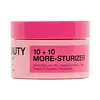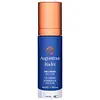What's inside
What's inside
 Key Ingredients
Key Ingredients

 Benefits
Benefits

 Concerns
Concerns

 Ingredients Side-by-side
Ingredients Side-by-side

Water
Skin ConditioningGlycerin
HumectantDimethicone
EmollientButyrospermum Parkii Butter
Skin ConditioningCaprylic/Capric/Myristic/Stearic Triglyceride
EmollientC12-15 Alkyl Benzoate
Antimicrobial3-O-Ethyl Ascorbic Acid
Skin ConditioningTapioca Starch
Cetearyl Alcohol
EmollientArachidyl Alcohol
EmollientSqualane
EmollientCoco-Caprylate/Caprate
EmollientPentaerythrityl Tetraisostearate
EmollientTridecyl Trimellitate
EmollientPalmitoyl Tetrapeptide-7
Skin ConditioningPalmitoyl Tripeptide-1
Skin ConditioningTetrahexyldecyl Ascorbate
AntioxidantCeramide NP
Skin ConditioningCaprylyl Glycol
EmollientCaprylyl/Capryl Glucoside
CleansingLinoleic Acid
CleansingCitric Acid
BufferingPhytosterols
Skin ConditioningGlucose
HumectantSodium Acrylate/Sodium Acryloyldimethyl Taurate Copolymer
Emulsion StabilisingBehenyl Alcohol
EmollientPolyisobutene
Bis-Diglyceryl Polyacyladipate-2
EmollientHydroxyacetophenone
Antioxidant1,2-Hexanediol
Skin ConditioningCetearyl Glucoside
EmulsifyingArachidyl Glucoside
EmulsifyingCarrageenan
Sorbitan Laurate
EmulsifyingSodium Phytate
C18-36 Acid Glycol Ester
EmollientC18-36 Acid Triglyceride
EmollientWater, Glycerin, Dimethicone, Butyrospermum Parkii Butter, Caprylic/Capric/Myristic/Stearic Triglyceride, C12-15 Alkyl Benzoate, 3-O-Ethyl Ascorbic Acid, Tapioca Starch, Cetearyl Alcohol, Arachidyl Alcohol, Squalane, Coco-Caprylate/Caprate, Pentaerythrityl Tetraisostearate, Tridecyl Trimellitate, Palmitoyl Tetrapeptide-7, Palmitoyl Tripeptide-1, Tetrahexyldecyl Ascorbate, Ceramide NP, Caprylyl Glycol, Caprylyl/Capryl Glucoside, Linoleic Acid, Citric Acid, Phytosterols, Glucose, Sodium Acrylate/Sodium Acryloyldimethyl Taurate Copolymer, Behenyl Alcohol, Polyisobutene, Bis-Diglyceryl Polyacyladipate-2, Hydroxyacetophenone, 1,2-Hexanediol, Cetearyl Glucoside, Arachidyl Glucoside, Carrageenan, Sorbitan Laurate, Sodium Phytate, C18-36 Acid Glycol Ester, C18-36 Acid Triglyceride
Water
Skin ConditioningCaprylic/Capric Triglyceride
MaskingPentylene Glycol
Skin ConditioningPropylene Glycol
HumectantHydrogenated Phosphatidylcholine
EmulsifyingGlycerin
HumectantSorbitol
HumectantTocopheryl Acetate
AntioxidantButyrospermum Parkii Butter
Skin ConditioningXanthan Gum
EmulsifyingButylene Glycol
HumectantPanthenol
Skin ConditioningSodium Carbomer
Emulsion StabilisingAloe Barbadensis Leaf Juice
Skin ConditioningAlcohol
AntimicrobialHydrolyzed Rice Protein
Skin ConditioningSqualane
EmollientHelianthus Annuus Seed Oil
EmollientPhenoxyethanol
PreservativeSodium Hydroxide
BufferingCarbomer
Emulsion StabilisingLecithin
EmollientCholesterol
EmollientHydrogenated Lecithin
EmulsifyingAscorbyl Palmitate
AntioxidantCeramide NP
Skin ConditioningGlycine Soja Protein
EmulsifyingSuperoxide Dismutase
AntioxidantCitric Acid
BufferingDextran
Palmitoyl Tripeptide-8
Skin ConditioningAlanyl Glutamine
HumectantArginine
MaskingCeramide Ng
Skin ConditioningGlycine
BufferingLysine
Skin ConditioningOleic Acid
EmollientPalmitic Acid
EmollientPhenylalanine
MaskingProline
Skin ConditioningScenedesmus Rubescens Extract
Skin ConditioningAscorbic Acid
AntioxidantRetinyl Palmitate
Skin ConditioningSodium Benzoate
MaskingPotassium Sorbate
PreservativeEthylhexylglycerin
Skin ConditioningSodium Dextran Sulfate
Gel FormingBetula Alba Oil
MaskingDisodium EDTA
Oligopeptide-177
Sodium Ascorbate
AntioxidantTocopherol
AntioxidantWater, Caprylic/Capric Triglyceride, Pentylene Glycol, Propylene Glycol, Hydrogenated Phosphatidylcholine, Glycerin, Sorbitol, Tocopheryl Acetate, Butyrospermum Parkii Butter, Xanthan Gum, Butylene Glycol, Panthenol, Sodium Carbomer, Aloe Barbadensis Leaf Juice, Alcohol, Hydrolyzed Rice Protein, Squalane, Helianthus Annuus Seed Oil, Phenoxyethanol, Sodium Hydroxide, Carbomer, Lecithin, Cholesterol, Hydrogenated Lecithin, Ascorbyl Palmitate, Ceramide NP, Glycine Soja Protein, Superoxide Dismutase, Citric Acid, Dextran, Palmitoyl Tripeptide-8, Alanyl Glutamine, Arginine, Ceramide Ng, Glycine, Lysine, Oleic Acid, Palmitic Acid, Phenylalanine, Proline, Scenedesmus Rubescens Extract, Ascorbic Acid, Retinyl Palmitate, Sodium Benzoate, Potassium Sorbate, Ethylhexylglycerin, Sodium Dextran Sulfate, Betula Alba Oil, Disodium EDTA, Oligopeptide-177, Sodium Ascorbate, Tocopherol
Ingredients Explained
These ingredients are found in both products.
Ingredients higher up in an ingredient list are typically present in a larger amount.
This ingredient is also known as shea butter. It is an effective skin hydrator and emollient.
Emollients help soothe and soften your skin. It does this by creating a protective film on your skin. This barrier helps trap moisture and keeps your skin hydrated. Emollients may be effective at treating dry or itchy skin.
Shea butter is rich in antioxidants. Antioxidants help fight free-radicals, or molecules that may harm the body. It is also full of fatty acids including stearic acid and linoleic acid. These acids help replenish the skin and keep skin moisturized.
While Shea Butter has an SPF rating of about 3-4, it is not a sunscreen replacement.
Shea butter may not be fungal acne safe. We recommend speaking with a professional if you have any concerns.
Learn more about Butyrospermum Parkii ButterCeramide NP is a type of ceramide and formally known as ceramide 3.
Ceramides are intercellular lipids naturally found in our skin that bonds dead skin cells together to create a barrier. They are known for their ability to hold water and thus are a great ingredient for dry skin.
Ceramides are an important building block for our skin barrier. A stronger barrier helps the skin look more firm and hydrated. By bolstering the skin ceramides act as a barrier against irritating ingredients. This can help with inflammation as well.
If you would like to eat ceramides, sweet potatoes contain a small amount.
Read more about other common types of ceramides here:
Ceramide AP
Ceramide EOP
Citric Acid is an alpha hydroxy acid (AHA) naturally found in citrus fruits like oranges, lemons, and limes.
Like other AHAs, citric acid can exfoliate skin by breaking down the bonds that hold dead skin cells together. This helps reveal smoother and brighter skin underneath.
However, this exfoliating effect only happens at high concentrations (20%) which can be hard to find in cosmetic products.
Due to this, citric acid is usually included in small amounts as a pH adjuster. This helps keep products slightly more acidic and compatible with skin's natural pH.
In skincare formulas, citric acid can:
While it can provide some skin benefits, research shows lactic acid and glycolic acid are generally more effective and less irritating exfoliants.
Most citric acid used in skincare today is made by fermenting sugars (usually from molasses). This synthetic version is identical to the natural citrus form but easier to stabilize and use in formulations.
Read more about some other popular AHA's here:
Learn more about Citric AcidGlycerin is already naturally found in your skin. It helps moisturize and protect your skin.
A study from 2016 found glycerin to be more effective as a humectant than AHAs and hyaluronic acid.
As a humectant, it helps the skin stay hydrated by pulling moisture to your skin. The low molecular weight of glycerin allows it to pull moisture into the deeper layers of your skin.
Hydrated skin improves your skin barrier; Your skin barrier helps protect against irritants and bacteria.
Glycerin has also been found to have antimicrobial and antiviral properties. Due to these properties, glycerin is often used in wound and burn treatments.
In cosmetics, glycerin is usually derived from plants such as soybean or palm. However, it can also be sourced from animals, such as tallow or animal fat.
This ingredient is organic, colorless, odorless, and non-toxic.
Glycerin is the name for this ingredient in American English. British English uses Glycerol/Glycerine.
Learn more about GlycerinSqualane is an emollient that helps the skin hold onto moisture. It's an oily liquid that occurs naturally in certain types of fish and plant oils.
Because squalane boosts hydration in the skin, it also comes with plenty of benefits: it is an antioxidant and can help fight free radicals and skin damage. Squalane is also found to have a detoxifying effect when applied.
Squalane comes from squalene, which occurs naturally within the sebum of our skin. It is one of the oils our skin produces to keep itself hydrated. Squalane is the hydrogenated version of squalene and has a longer shelf life.
Research shows that squalane is non-irritating (even at 100% concentration).
In general, it's a fantastic ingredient. It does a great job at hydrating the skin, and it's suitable for those with sensitive skin.
The source of squalane may impact malassezia / fungal acne. This is because olive oil derived squalane can contain impurities such as fatty acids and plant waxes. Sugarcane derived squalane is recommended for anyone with malassezia concerns.
Is squalane vegan?
This depends on the source. Squalane can be derived from both plants and animals. Most squalane used in skincare comes from plants.
Please note: the source of squalane is only known if disclosed by the brand. We recommend reaching out to the brand if you have any questions about their squalane.
Read more about squalene with an "e".
Is squalane an oil?
Squalane is often called an oil, but it’s technically not; it’s a hydrocarbon, meaning it’s only made of carbon and hydrogen, unlike true oils which are triglycerides made of fatty acids and glycerol.
The term “oil-free” isn’t regulated, so companies can define it however they want. Some exclude all oils, while others just avoid mineral oil or comedogenic oils.
While some people avoid oils thinking they cause breakouts, the right kind of oil (or oil-like ingredient like squalane) can actually help balance and hydrate your skin. It’s worth testing out simple oils or squalane to see what works best for your skin.
Learn more about SqualaneWater. It's the most common cosmetic ingredient of all. You'll usually see it at the top of ingredient lists, meaning that it makes up the largest part of the product.
So why is it so popular? Water most often acts as a solvent - this means that it helps dissolve other ingredients into the formulation.
You'll also recognize water as that liquid we all need to stay alive. If you see this, drink a glass of water. Stay hydrated!
Learn more about Water